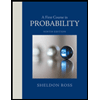
A First Course in Probability (10th Edition)
10th Edition
ISBN: 9780134753119
Author: Sheldon Ross
Publisher: PEARSON
expand_more
expand_more
format_list_bulleted
Question
thumb_up100%
Please solve problem. This is one problem with multiple parts answer each carefully
![### Probability Exercise
#### Part 3 of 5
(c) Given:
- \( n = 8 \)
- \( p = 0.38 \)
- \( X = 5 \)
Calculate:
\[ P(X) = \]
---
#### Progress Indicator
- Part: 3 / 5
A progress bar is shown indicating that the exercise is 60% complete.
---
#### Part 4 of 5
(d) Given:
- \( n = 5 \)
- \( p = 0.45 \)
- \( X = 0 \)
Calculate:
\[ P(X) = \]
---
#### Progress Indicator
- Part: 4 / 5
A progress bar is shown indicating that the exercise is 80% complete.
---
#### Part 5 of 5
(e) Given:
- \( n = 3 \)
- \( p = 0.48 \)
- \( X = 1 \)
Calculate:
\[ P(X) = \]
---
### Note:
In this exercise, you are required to calculate the probability \( P(X) \) for different sets of conditions in binomial distributions. Each part provides a specific set of parameters including the number of trials \( n \), the probability of success \( p \), and the number of successes \( X \).](https://content.bartleby.com/qna-images/question/bb4c002f-184e-4d4b-8f58-b85aac470a18/100735c8-c30d-49af-931e-72e21272984f/glutvzt_thumbnail.jpeg)
Transcribed Image Text:### Probability Exercise
#### Part 3 of 5
(c) Given:
- \( n = 8 \)
- \( p = 0.38 \)
- \( X = 5 \)
Calculate:
\[ P(X) = \]
---
#### Progress Indicator
- Part: 3 / 5
A progress bar is shown indicating that the exercise is 60% complete.
---
#### Part 4 of 5
(d) Given:
- \( n = 5 \)
- \( p = 0.45 \)
- \( X = 0 \)
Calculate:
\[ P(X) = \]
---
#### Progress Indicator
- Part: 4 / 5
A progress bar is shown indicating that the exercise is 80% complete.
---
#### Part 5 of 5
(e) Given:
- \( n = 3 \)
- \( p = 0.48 \)
- \( X = 1 \)
Calculate:
\[ P(X) = \]
---
### Note:
In this exercise, you are required to calculate the probability \( P(X) \) for different sets of conditions in binomial distributions. Each part provides a specific set of parameters including the number of trials \( n \), the probability of success \( p \), and the number of successes \( X \).
![**Compute the probability of X successes using the binomial formula. Round your answers to three decimal places as needed.**
---
**Part: 0 / 5**
**Part 1 of 5**
(a) \( n = 3, \, p = 0.72, \, X = 1 \)
\[ P(X) = \square \]
---
**Part: 1 / 5**
[Progress bar indicating progress toward completion of Part 1 of 5]
---
**Part 2 of 5**
(b) \( n = 3, \, p = 0.55, \, X = 0 \)
\[ P(X) = \square \]
---
**Part: 2 / 5**
[Progress bar indicating progress toward completion of Part 2 of 5]](https://content.bartleby.com/qna-images/question/bb4c002f-184e-4d4b-8f58-b85aac470a18/100735c8-c30d-49af-931e-72e21272984f/bi3bht_thumbnail.jpeg)
Transcribed Image Text:**Compute the probability of X successes using the binomial formula. Round your answers to three decimal places as needed.**
---
**Part: 0 / 5**
**Part 1 of 5**
(a) \( n = 3, \, p = 0.72, \, X = 1 \)
\[ P(X) = \square \]
---
**Part: 1 / 5**
[Progress bar indicating progress toward completion of Part 1 of 5]
---
**Part 2 of 5**
(b) \( n = 3, \, p = 0.55, \, X = 0 \)
\[ P(X) = \square \]
---
**Part: 2 / 5**
[Progress bar indicating progress toward completion of Part 2 of 5]
Expert Solution
This question has been solved!
Explore an expertly crafted, step-by-step solution for a thorough understanding of key concepts.
This is a popular solution
Trending nowThis is a popular solution!
Step by stepSolved in 2 steps with 2 images

Knowledge Booster
Similar questions
- Solve the problem by showing the necessary steps to justify the answer: One number is four more than a second number. Two times the first number is 12 more than four times the second number.arrow_forwardThe number of hours per week that the television is turned on is determined for each family in a sample. The mean of the data is 31 hours and the median is 27.2hours. Twenty-four of the families in the sample turned on the television for 16 hours or less for the week. The 8th percentile of the data is 16 hours. Based on the given information, determine if the following statement is true or false. The first quartile is less than 16 hours.arrow_forward
Recommended textbooks for you
 A First Course in Probability (10th Edition)ProbabilityISBN:9780134753119Author:Sheldon RossPublisher:PEARSON
A First Course in Probability (10th Edition)ProbabilityISBN:9780134753119Author:Sheldon RossPublisher:PEARSON

A First Course in Probability (10th Edition)
Probability
ISBN:9780134753119
Author:Sheldon Ross
Publisher:PEARSON
